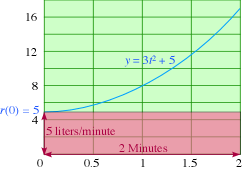
(This topic is also in Section 6.3 in Applied Calculus and Section 13.3 in Finite Mathematics and Applied Calculus)

 | Numerical Integration Utility | Excel Riemann Sum Grapher | ||||
| Graphing Calculator Programs |  | Online Text: Numerical Integration | ||||

In the textbook we consider an example (Example 1) based in which you are given the marginal cost of making a cell phone call and need to compute the total cost of a two hour call. Instead of going over the same example here, we look at a slightly different scenario here:
The Main Example: A pump is delivering water into a tank at a rate of
First Rough Calculation: Since r(t) is the number of liters per minute at which water is entering the tank, when the pump is turned on, this rate is
| Total amount pumped in | = | Number of liters/minute × Number of Minutes |
| = | r(0) × 2 | |
| = | 5 × 2 = 10 liters |
Here is a graph showing that calculation we just did:
 |
| Total amount pumped in = 5 liters/minute × 2 Minutes |
Notice two things:
Referring t the second point above, the reason that we have underestimated the total amount pumped in is that we used the initial rate r(0) throughout the entire 2-minute period.
Let us now redo the calculation using a minute-by-minute calculation, using the rate at the start of each minute for the calculation for that minute:
| Minute 1: Total amount pumped in | = | Number of liters/minute at the start of minute 1 × Number of Minutes |
| = | r(0) × 1 | |
| = | 5 × 1 = 5 liters |
This gives a more accurate estimate of the total amount pumped in as
The new calculation is shown in the following graph:
 |
| Minute 1: 5 liters/minute × 1 Minute = 5 liters Minute 2: 8 liters/minute × 1 Minute = 8liters |
Notice that the new estimate is given by the sum of the areas of the two red rectangles.
But wait! This answer is still not exact: For instance, during Minute 1, the rate does not remain constant at 5 liters/minute, but is increasing there as well, and during the second minute, the rate is not constant at 8 liters/minute either. So we will next compute a more accurate third answer by using half-minute by half-minute calculations. But before we go on, let is write down what we have computed using Δt to denote the length of time we use in each step of the computation:
| First Calculation (Δt = 2): | r(0)Δt = 5×2 = 10 liters |
| Second Calculation (Δt = 1): | r(0)Δt + r(1)Δt = 5×1 + 8×1 = 13 liters |
| Thied Calculation (Δt = 0.5): | r(0)Δt + r(0.5)Δt + r(1)Δt + r(1.5)Δt = 5×0.5 + 5.75×0.5 + 8×0.5 + 11.75×0.5 = 15.25 liters |
Each of these calculations is called a left Riemann sum of the function r(t); the first calculation is a Riemann sum with 1 subdivision, the second a Riemann sum with 2 subdivisions, and the third Riemann sum with 4 subdivisions.
Here is the graph for the third calculation:
| Riemann Sum with 4 subdivisions:
r(0)Δt + r(0.5)Δt + r(1)Δt + r(1.5)Δt = 15.25 liters |

To obtain the Riemann sum, we add the areas of all five rectangles. The area of each rectangle is its height times its width Δt (0.4). Instead of multiplying each height by 0.4 and then adding, we can equivalently add the heights and multiply the sum by 0.4: